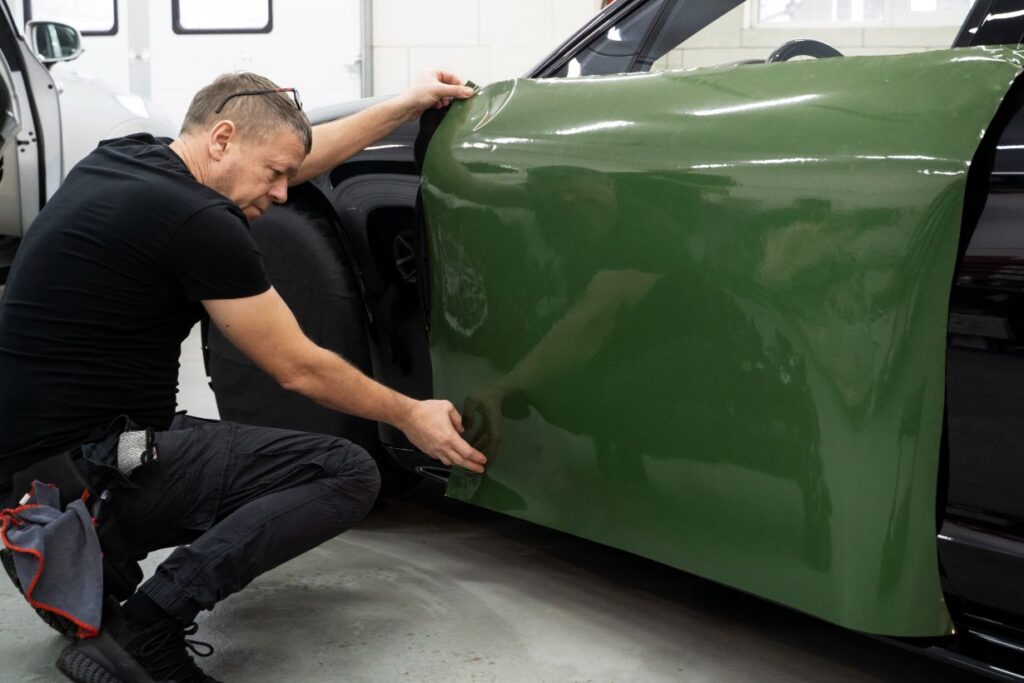When considering Car wrapping for your vehicle, one of the most important questions is, “how much wrap is needed for a car?” Determining the correct amount of Vinyl wrap is essential to ensure that the job can be completed without any interruptions. At the same time, you also want to avoid purchasing too much material, which can lead to unnecessary costs. In this article, we will explore how to estimate the right amount of Vehicle wrap, the factors that affect the quantity, and other considerations you should keep in mind when planning to wrap a car.
How Much Wrap is Needed for a Car?
The answer to “how much wrap is needed for a car” depends on several factors, such as the size of the vehicle, the complexity of its design, and whether you’re wrapping the entire car or just specific sections. In general, most vehicles will require anywhere between 50 to 75 feet of Vinyl wrap to cover the entire surface. This estimation accounts for the average car’s dimensions, but variations in vehicle type and design complexity can change the final amount required.
1. Vehicle Size and Shape
The primary factor affecting how much wrap is needed for a car is the vehicle’s size. A small car like a compact or a sedan will obviously need less Vinyl wrap than a large SUV or truck. Here’s a rough breakdown of how much Vehicle wrap is typically required based on vehicle size:
- Small cars (compact, hatchback, sedan): These vehicles generally need between 50 to 60 feet of Vinyl wrap.
- Midsize cars (coupes, larger sedans): For a midsize car, you may need around 60 to 65 feet of Vehicle wrap.
- Large vehicles (SUVs, trucks, vans): Larger vehicles can require up to 70 to 75 feet of auto wrap.
Additionally, the shape of the vehicle plays a role. Cars with more curves, complex contours, or intricate designs may need extra material to ensure proper coverage, as Car wrapping over curved areas uses more Vinyl wrap than flat surfaces.
2. Full Wrap vs. Partial Wrap
Another critical factor in determining how much wrap is needed for a car is whether you plan to do a full wrap or a partial wrap. A full Vehicle wrap will cover the entire surface of the car, including the hood, roof, doors, and bumpers. As mentioned, this can require up to 75 feet of Vinyl wrap for larger vehicles. On the other hand, a partial wrap focuses on certain sections of the car, such as the hood, roof, or side panels, reducing the total amount of material needed.
For a partial wrap a car job, you might only need 10 to 20 feet of auto wrap, depending on which areas of the car you intend to cover. Partial wraps are an excellent option if you’re working with a limited budget or just want to add specific accents to your vehicle rather than covering the whole car.
3. Wrap Widths
Vinyl wrap typically comes in two standard widths: 60 inches and 48 inches. Most vehicles require the wider 60-inch rolls to minimize seams and provide better coverage. Wider wraps are especially useful when covering larger areas such as the hood or roof. When calculating how much wrap is needed for a car, it’s essential to consider the width of the Vehicle wrap you’re purchasing. Wider wraps may cover more surface area per foot, but they also cost more than narrower wraps.
4. Allow for Extra Material
When determining how much wrap is needed for a car, always account for some extra material. Cutting, trimming, and adjusting the Vinyl wrap to fit the contours of the car will naturally lead to some waste. You’ll want to ensure you have a little more material than the exact surface area to avoid running short mid-project.
For example, when calculating the amount of Vehicle wrap, it’s advisable to order around 10% more than you think you’ll need. This extra material can help cover mistakes, overlaps, or anyareas that may have been underestimated.
5. Professional vs. DIY Wrapping

Whether you’re opting for a professional Car wrapping service or planning to wrap a car yourself can also impact how much wrap is needed for a car. Professional installers are experienced in working with Vinyl wrap and tend to minimize waste during the installation process. They’ll use just the right amount of auto wraps for the job.
If you’re attempting a DIY Vehicle wrap project, you may need to account for more waste, especially if you’re unfamiliar with the technique. In this case, you should be even more generous when ordering extra material to allow for mistakes or miscuts.
6. Wrapping Additional Features
Many people focus only on the main body when calculating how much wrap is needed for a car, but don’t forget about additional features such as mirrors, door handles, and bumpers. These parts require smaller sections of Vinyl wrap, but they still contribute to the overall amount of material required. Depending on the complexity of the design and the number of extra features, you may need to add a few more feet to your total estimate.
7. Wrapping Interior Elements

Some car owners choose to wrap interior elements of their vehicles, such as dashboard panels or center consoles, in addition to the exterior. If you’re considering this option, you’ll need to account for the extra material required to wrap a car both inside and out.
Interior wrapping uses much less Vinyl wrap than exterior wrapping, but it’s still important to include these sections when determining how much wrap is needed for a car. A few extra feet of Vehicle wrap should be sufficient for most interior features.
Conclusion:
So, how much wrap is needed for a car? The answer depends on several factors, including the size of the vehicle, whether you’re doing a full or partial wrap, and the complexity of the car’s shape. On average, most cars will need between 50 and 75 feet of Vinyl wrap for a full Vehicle wrap, while smaller vehicles or partial wraps will require less material.
Before starting any Car wrapping project, it’s crucial to measure the dimensions of your car and consider how much material might be needed for additional features or waste. By accounting for these variables and ordering a little extra to be safe, you can ensure your wrap a car project goes smoothly.
Whether you’re tackling the project on your own or hiring professionals, calculating how much wrap is needed for a car is the first step toward transforming your vehicle with a fresh new look. A well-executed auto wrap can offer both aesthetic appeal and protection, making it a great option for car enthusiasts everywhere.



